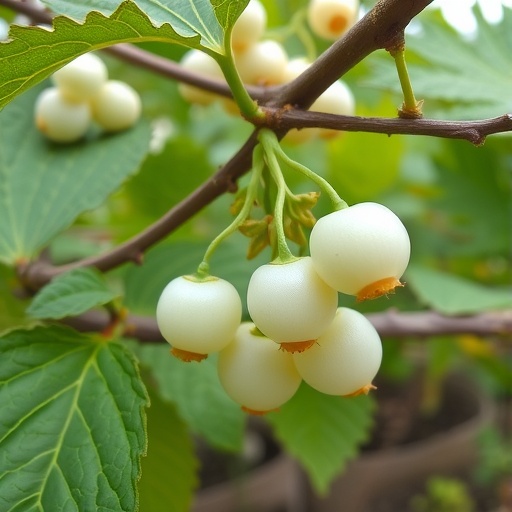A groundbreaking study has emerged from the world of environmental science, centering on the intricate relationship between nitrogenous fertilizers and the accumulation of cadmium (Cd) in agricultural systems. This critical research, conducted by Jiang et al., sheds light on how these fertilizers not only enhance crop growth but also influence toxic metal distribution within the soil-mulberry-silkworm ecosystem. As agricultural practices increasingly come under scrutiny for their environmental impacts, this work aims to fill the knowledge gap regarding the safe utilization of contaminated farmland.
Cadmium is a heavy metal recognized for its toxicity and potential to accumulate in the food chain, posing serious health risks to humans and other organisms. Found abundantly in certain soils and often entering agricultural systems through various anthropogenic activities, cadmium’s pathway into crops is a major concern. In areas where nitrogenous fertilizers are heavily applied, understanding the dynamics of cadmium uptake becomes increasingly crucial for sustainable agricultural practices.
The authors initiated their investigation by examining the interaction between soil properties, nitrogenous fertilizer applications, and cadmium accumulation. They meticulously designed a series of experiments to understand these factors’ interplay in a controlled environment. The study provides valuable insights into how soil pH, organic matter content, and microbial activity can alter the bioavailability of cadmium, thereby influencing its uptake by crops, particularly mulberry trees.
Interestingly, the study highlights that nitrogenous fertilizers, while essential for increasing crop yield, can inadvertently create conditions that enhance cadmium availability in the soil. The researchers observed that specific fertilizers led to changes in soil chemistry that increased cadmium solubility. This finding indicates that while farmers aim to boost productivity through fertilization, they may unwittingly contribute to the mobilization of harmful heavy metals.
As the research progressed, the team also explored the implications for silkworms, which rely on mulberry leaves as their primary diet. Silkworms, being a crucial part of the agricultural economy, particularly in regions where silk production is a leading industry, raise concerns about the transfer of cadmium. The study reveals that feeding silkworms contaminated mulberry leaves could lead to significant cadmium bioaccumulation in their tissues. Hence, this threat extends not only to crop health but also to the livelihood of farmers and the safety of silk products.
The broader implications of the findings cannot be overstated. As consumers become increasingly aware of food safety issues, the bioaccumulation of cadmium in food webs poses a significant challenge for sustainable farming. With escalating concerns over food safety, it is paramount for the agricultural community to reassess the current practices surrounding nitrogenous fertilizer use and its unintended consequences on crop and animal health.
This research also underscores the necessity of developing guidelines for nitrogen fertilizer use in contaminated areas. The observed relationships between fertilizer application, cadmium bioavailability, and crop uptake must inform policy and agricultural practices. As environmental regulations intensify worldwide, farmers may need to adapt their fertilization strategies, prioritizing both yield and safety to meet consumer demands and regulatory standards.
The study’s ramifications extend beyond immediate agricultural practices, pointing toward a future of enhanced monitoring of soil health and metal accumulation. By advocating for the safe utilization of contaminated farmland, the authors call for a more integrated approach to land management. This could include regular soil assessments, the implementation of remediation techniques, and tailored fertilization strategies that mitigate risks without compromising agricultural productivity.
In conclusion, Jiang et al.’s research papers a stark warning to the agricultural sector about the dual-edged sword of nitrogenous fertilizers. While they are indispensable in promoting crop growth, their role in cadmium accumulation could jeopardize both food safety and environmental integrity. The findings compel stakeholders to prioritize sustainable practices that consider ecological health within agricultural productivity paradigms. As this study continues to circulate within scientific communities and beyond, it may catalyze essential discussions about the future of food safety and environmental stewardship in agriculture.
With this pivotal research on the soil-mulberry-silkworm system in mind, it’s time for the agricultural community to take the reins and ensure that practices evolve in conjunction with scientific advancements. Only through awareness, regulation, and innovative solutions can the sector hope to balance productivity with safety and sustainability. As we forge ahead, navigating these complex interactions between agriculture and environmental health will be vital for both current and future generations.
Subject of Research: The impact of nitrogenous fertilizers on cadmium accumulation in the soil-mulberry-silkworm system and its implications for safe agricultural practices.
Article Title: Nitrogenous fertilizers affect Cd accumulation in the soil-mulberry-silkworm system: implications for safe utilization of contaminated farmland.
Article References:
Jiang, Y., Yang, X., Jiang, S. et al. Nitrogenous fertilizers affect Cd accumulation in the soil-mulberry-silkworm system: implications for safe utilization of contaminated farmland.
Environ Monit Assess 197, 1108 (2025). https://doi.org/10.1007/s10661-025-14588-0
Image Credits: AI Generated
DOI:
Keywords: Cadmium, nitrogenous fertilizers, soil health, agricultural practices, bioaccumulation, silkworms, food safety, contaminated farmland.




